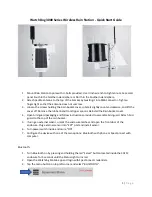
890464_k•en•2019-10-01
We reserve the right to carry out improvements
2
The radio control range is limited by legal regulations for
radio systems and by structural factors. Adequate radio
reception must be taken into consideration when planning
the system. This is particularly important when the radio
signal must pass through walls and ceilings. The control
unit should not be installed in the immediate vicinity of
metal components (steel beams, steel-reinforced concrete,
fire door).
Therefore, check that the receiver is functioning prop-
erly before the final installation.
Strong local transmitter systems (e.g. baby monitors or
neighbouring transmitters) can interfere with the reception.
Nnstallation
This device is designed for surface mounting on a build-
ing facade. It can also be mounted on a pole using the
included cable ties.
Included fixing materials:
2 screws 4.5 x 40 mm
2 dowels 6 mm
2 spacers for wall and ceiling installation (Fig. 2)
2 steel cable ties 360 mm
Use suitable fixing materials only. Depending on the
substructure (e.g. plastered outer insulation), other
screws and dowels may need to be used.
Do not remove the protective cap of the wind current
sensor until the device is fully installed.
Nmportant information on the installation location
Attach the device outdoors at a readily accessible but
raised location.
Metal-clad buildings, domestic interference sources
(unshielded household appliances, television sets,
computers), supply lines and metallic objects such
as sheet metal enclosures must have a distance of at
least 0.5 m from the weather station.
Install the device in a position in which the wind current
sensor is horizontal (housing inclination of 15°). When
installing the device on sloped surfaces, the sensor
can be positioned horizontally using the joint (Fig. 1).
When selecting an installation location, ensure that
precipitation can fall onto the sensor surface from all
directions without being obstructed. For example, an
overhanging roof may shield the panel.
Before installing the device, consider that trees, bushes
or parts of the building may shade the photo sensor
during the course of the day. In this case, the sen-
sor cannot deliver exact values and the results will
be incorrect. Therefore, select the installation location
carefully.
When selecting an installation location, ensure that the
photo sensor is exposed to the same brightness condi-
tions as the sun shading product being controlled. This
means that you need to position the photodiodes ac-
cording to the building facades being shaded. Ideally,
the weather station is oriented in the same direction as
the sun shading product being controlled.
Mount the device in the vicinity of the sun shading
product although not in places where the sun shading
product affects the wind currents; otherwise, the sen-
sor will not provide correct wind readings.
Separate spacers are included for wall and ceiling
installation. They prevent cracking and deformation of
the plastic (Fig. 2).
Fig. 2 Clipping the separate spacers into the threaded hole
Additional installation information can be found in the
documentation of your sun shading product.
Mounting plate
4,5
9,0
207,5
4,5
9,0
56
185
Fig. 3 Dimensions






























